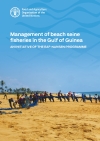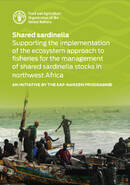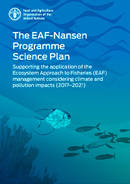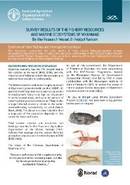EAF-Nansen Programme Communication material

The projects to support the management of beach seine fisheries in the Gulf of Guinea are aimed at supporting the implementation of concerted management plans in order to harmonize fisheries management through regional collaboration.
The projects contribute to the expected results of the EAF-Nansen Programme, particularly that fisheries management institutions manage fisheries according to the EAF principles and related indicators. The projects contribute also towards achieving the following United Nations Sustainable Development Goals: SDG 1 (No Poverty), SDG 2 (Zero Hunger), SDG 5 (Gender Equality), SDG 13 (Climate Action) and SDG 14 (Life below Water).

The project Supporting the implementation of the United Republic of Tanzania’s small and medium pelagic fisheries management plan is based on the ecosystem approach to fisheries (EAF) and focuses on strengthening capacities, structures as well as processes for fisheries management. The project is designed to support the implementation of the plan, mainly through the establishment of a functional fisheries management cycle (FMC). The overall objective is that small and medium-size pelagic fisheries in the United Republic of Tanzania are managed more efficiently and create sustainable benefits.
The project contributes to the EAF-Nansen Programme’s intended overall outcomes, in particular on how fisheries management institutions manage fisheries according to the EAF principles, and its relevant indicators. The project is also intended to contribute to the achievement of the following United Nations Sustainable Development Goals: SD1 ("no poverty"), SDG2 ("zero hunger"), SDG5 ("gender equality"), SDG13 ("climate action") and SDG14 ("life below water").

The project responds to the need for regional collaboration on the management of shared sardinella stocks. On the regional and national level, the projects aim to promote an ecosystem approach to fisheries (EAF) in strengthening capacities, structures and fisheries management processes through the development and use of the fisheries management cycle (FMC). The initiative contributes to the expected results of the EAF-Nansen Programme: “fisheries management institutions manage fisheries according to the EAF principles” and related indicators. The projects contribute also towards achieving the following United Nations Sustainable Development Goals: SDG1 ("no poverty"), SDG2 ("zero hunger"), SDG5 ("gender equality"), SDG13 ("climate change") and SDG14 ("life below water").

This document describes the overall principles and main thematic areas of the EAF-Nansen Programme Science Plan, including the use of the research vessel (R/V) Dr Fridtjof Nansen as a key tool for fieldwork. Three main research areas were identified, dealing with impacts of fishing, oil/gas activities and presence of contaminants, and climate variability and change on marine resources and ecosystems. These research areas are then subdivided into 11 main themes. Data used for the research activities were collected through the surveys with the R/V Dr Fridtjof Nansen, including the data gathered during the previous phases of the Nansen Programme.

This policy brief summarises the main results of three marine fishery/ecosystem surveys conducted in Myanmar waters in 2013, 2015 and 2018, with the use of the research vessel Dr Fridtjof Nansen. It also presents an overview of the main findings from previous surveys, by contrasting current and past findings. The brief provides useful key observations and recommendations.
